Having a properly set up enclosure for your leopard gecko is crucial to both their health and overall happiness under your care. From correct lighting to temperature to humidity and decorations, creating a leopard gecko habitat can be a confusing process, especially for novice reptile keepers. If you’re struggling with how to set up your leopard gecko’s habitat, check out our guide to leopard gecko tank setup ideas here!
We’ll cover everything you need to know about perfecting your new reptile friend’s home. In addition, we’ve added five great tips to elevate your gecko’s tank setup from basic to something truly extraordinary!
Leopard Gecko Tank Setup: The Basics
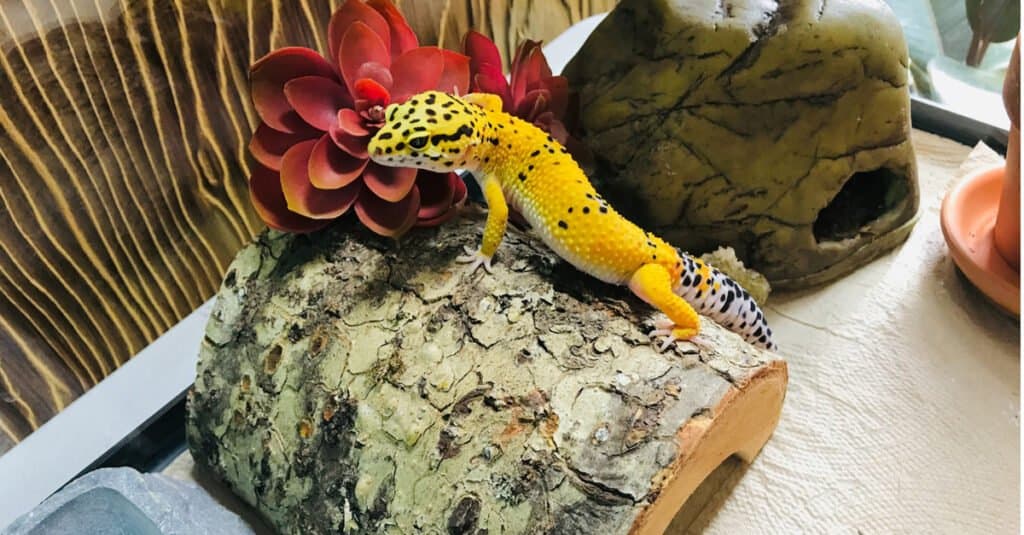
This
leopard gecko
enclosure has multiple hides, plants, proper substrate, and an interesting background
©Madison Stuczynski/Shutterstock.com
Before you get to playing with elaborate setups and decorations, it’s best to first thoroughly understand the basics your leopard gecko’s tank will need. Although leopard geckos are low-maintenance pets, they still have many unique care requirements that must be met for them to truly thrive in captivity.
Leopard gecko tank setup should imitate their natural habitat as closely as possible. The first thing to remember is that leopard geckos are native to Asia and found in the regions of Iraq, Iran, western parts of India, Afghanistan, and Pakistan. All of these regions have something in common. They are all dry desert-like environments with lots of heat and light.
The main things you’ll need to supply your leopard gecko tank with are:
- Adequate heating. The enclosure needs a gentle gradient from the hot side (the basking area) to the cooler side. Under the basking area, temperatures should be between 85 to 90F, while the cooler end should be between 75 to 80F. The temperatures in between the cold and hot sides should range from around 80 to 85F.
- Lighting and a 12/12 photocycle. Enclosure lighting should mimic natural sunlight: 12 hours on, 12 hours off. This can easily be achieved with a simple white basking bulb (which will also provide heat to your gecko’s habitat).
- Proper humidity. Since leopard geckos are desert dwellers, they need low humidity settings in captivity, or around 30% to 40% at all times. Keep moisture to a minimum. Place your gecko’s water dish away from the basking bulb to prevent evaporation (which adds more moisture to the air).
- Dry and humid hides. A hide is simply a small, covered shelter for your gecko to sleep in or find privacy if they’re feeling shy. The humid hide should be placed towards the middle of the enclosure, filled with damp substrate, and misted daily. The dry hide should be towards the cooler end of the enclosure and have a dry substrate.
- Safe substrate. Substrate makes up the floor of your gecko’s enclosure. Avoid “loose,” substrates, or those made up of small, indigestible particles. Sand, gravel, and wood chips, for example, are unsafe substrates, as your gecko could accidentally ingest them and become impacted. The safest options are tile, flat stones, reptile carpet, or paper towels.
- Food and water dishes. Keep these as clean as possible. Place the water dish towards the cooler end of the enclosure to prevent the water from evaporating and raising the tank’s humidity. Keep substrate out of your gecko’s food and water dish, especially during meal times.
- Decorations. From plants to bridge signs and other fun decorations, your gecko’s tank will need some clutter to make your pet feel sheltered and safe.
Now that you have a better idea of the basics your scaly friend’s habitat needs, let’s get into some fun leopard gecko tank setup ideas. These tips will elevate your pet’s tank from basic to beautiful in just a few simple and inexpensive steps!
Leopard Gecko Tank Setup: Experiment with Hides
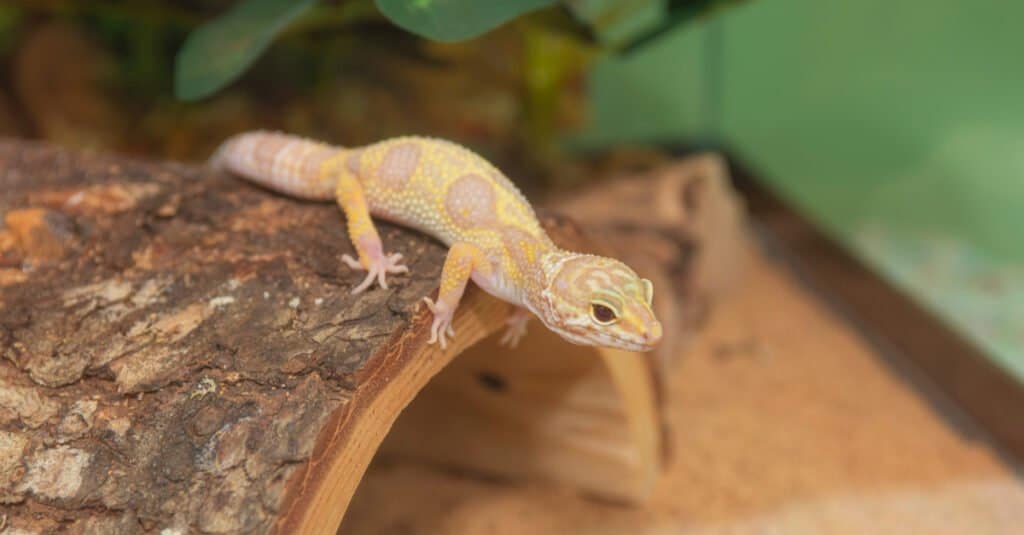
Hollowed-out logs are a popular choice of hide for leopard geckos
©LHolmes Photography/Shutterstock.com
As we briefly covered above, your gecko’s enclosure needs two hides: a dry hide and a humid hide. Thankfully, you have a lot of room for experimentation here as far as size, shape, and style go. Both of your gecko’s hides should be small enough to be cozy yet large enough to comfortably fit the lizard’s entire body. Aside from that, though, you can choose whatever hides look great to you or even make your own!
Some examples of hides on the market are hollowed-out coconuts, wooden logs, stone caves, or even those with built-in humidifiers if you don’t feel like misting your gecko’s humid hide every single day.
Leopard Gecko Tank Setup: Plants, Plants, Plants!

Leopard geckos love plant cover in their enclosures, despite not being natural climbers
©Vladislav_Bagnyuk/Shutterstock.com
Leopard geckos are terrestrial and don’t climb much naturally. However, they do still benefit from a generous amount of plant cover in their enclosures in captivity. It doesn’t really matter if the plants are real or artificial. Be warned, however, that genuine plants can raise the humidity to unsafe levels.
Another good reason to use artificial plants instead of actual plants is they last longer and are easier to set up, care for, and move, especially for novice reptile owners. Your gecko also has no risk of eating them, since leopard geckos are strictly insectivorous.
The best part is you can get pretty creative with them! Try using plants of different shapes and sizes (hanging vines, large, sturdy plants with lots of leaves, etc.) to give your gecko a bit more privacy. Plants also provide enrichment and encourage your gecko to explore and interact with their environment.
Leopard Gecko Tank Setup: Customize the Background

Leopard geckos enjoy enclosures with interesting backdrops
©Vladislav_Bagnyuk/Shutterstock.com
Most basic enclosures have transparent glass or mesh walls, which can be a bit boring for you and your gecko to look at. Being able to see out of their enclosure can also make your leo feel exposed or stressed, which is why lots of decor and plant cover is beneficial for them.
There’s a lot you can do when it comes to customizing the background in your gecko’s enclosure! Many brands and online retailers even sell premade backgrounds of desert landscapes that mimic your gecko’s natural habitat. Simply unroll the sheet, cut it to size, and either glue or tape it to the back of the enclosure!
Leopard Gecko Tank Setup: Experiment with Substrates
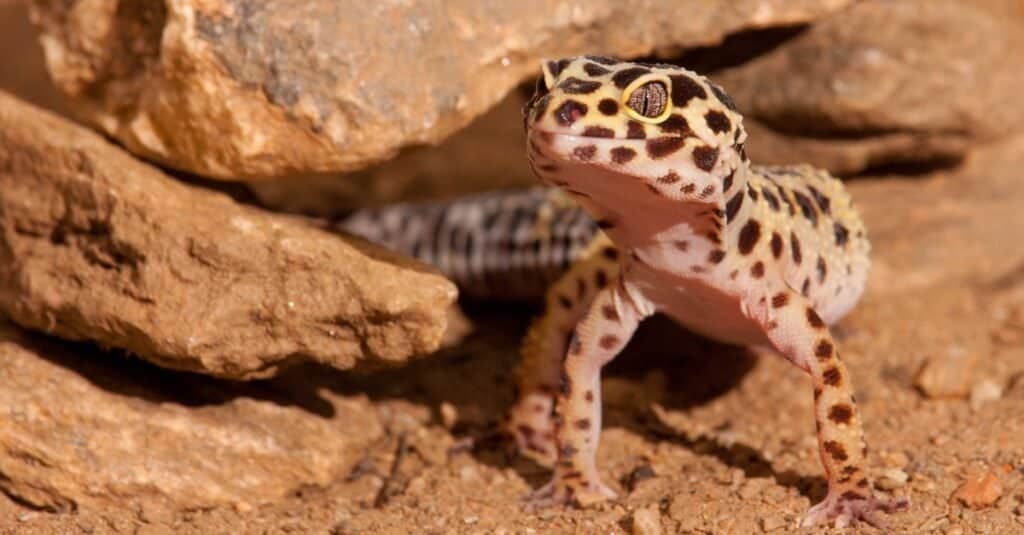
Leopard geckos’ native habitats are sandy, hilly deserts and scrublands
©iStock.com/Daniel Castillo
Substrates can also spruce up a reptile enclosure in a pinch, especially if you’re on a budget. Of course, using a safe substrate is crucial here. Many loose substrates contain small, indigestible particles. These substrates, such as sand, gravel, and wood chips, pose a risk of impaction.
Thankfully, there are just as many safe substrates that look great and feel great for your gecko to walk on, such as:
- Flat stones or tiles
- Stick-down linoleum
- Reptile carpet
- Reptile sand mats
- Bioactive substrates (not recommended for novice reptile keepers)
Try experimenting with these different substrates to find what looks best to you! Sand mats are especially natural-looking, and they are much safer than actual sand since the sand particles and pebbles are secured safely to the mat.
Leopard Gecko Tank Setup: Experiment with Elevation Variation
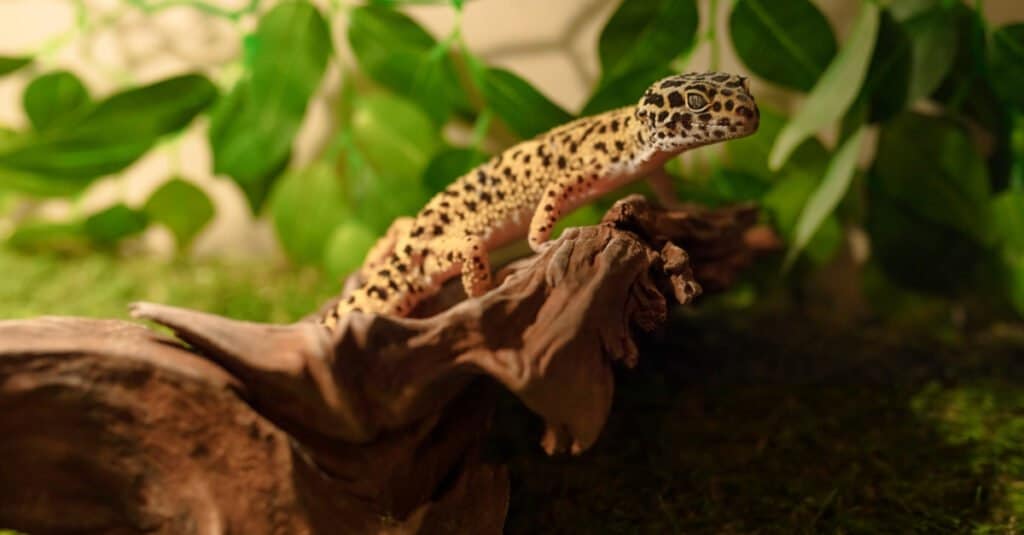
A leopard gecko explores a log in their enclosure
©Elena Belodedova/Shutterstock.com
If your leopard gecko’s enclosure doesn’t have much elevation to speak of, why not give it a bit more dimension? Although leopard geckos don’t climb as much as most other lizards, they do appreciate enclosures that aren’t completely flat. We love this one as far as leopard gecko tank setup ideas go because there’s so much room for customization!
Remember, you ideally want to mimic your pet’s natural habitat as closely as possible (within reason, of course). In the wild, leopard geckos live in hilly, sandy deserts and scrublands, which have lots of variation in their elevation and terrain. Try stacking flat stones, adding bridges, hammocks, or other platforms, or even small inclines here and there!
Not only will your gecko’s enclosure look better as a result, but your gecko will also enjoy the extra enrichment of exploring a more interesting-looking, authentic habitat.
Products Needed for Leopard Gecko Tank Setup
A vivarium
The size of the Vivarium should be long and not wide. Select one that is at least 86 cm in length and half of that in width.
Heat mat
Basking lamp
UV lamp
Infra-red heat lamp
Hygrometer
Thermometer
Suitable substrate and hides
Do Leopard Geckos Like to be Held?
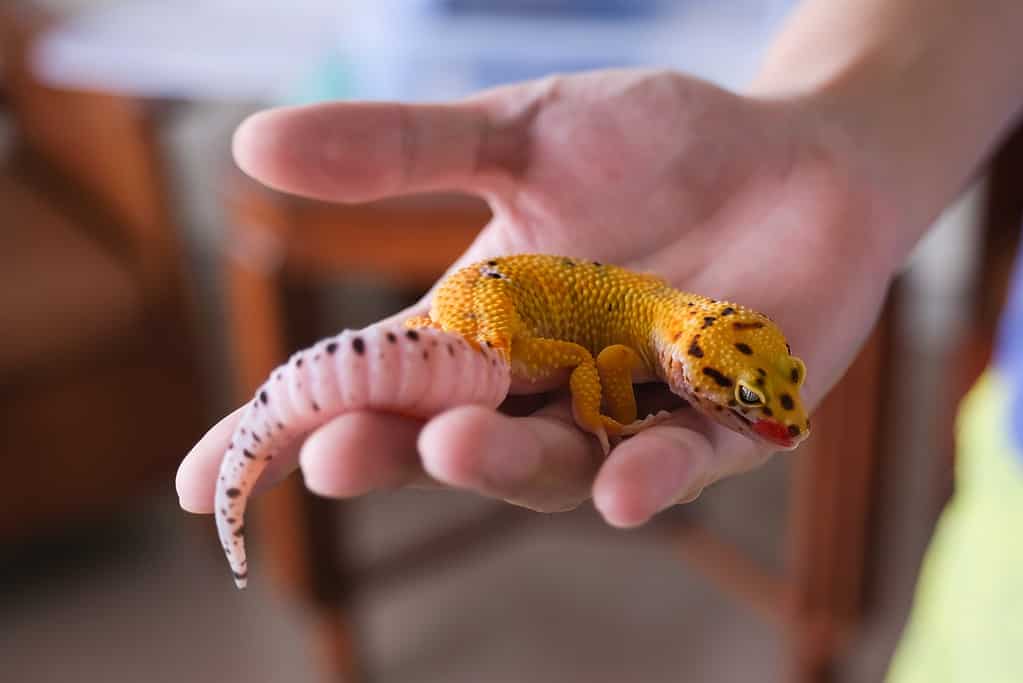
Leopard Geckos may not mind being held for brief periods throughout the day.
©Fresh Stocks/Shutterstock.com
Leopard geckos aren’t particularly fond of being held. However, if you get one when they are young, they may get used to being handled more frequently. When you first bring your gecko home, the best thing you should do is let it explore its new surroundings and feel comfortable before you start interacting with it. Then you should let your gecko get used to you.
Although they still won’t love being handled, they won’t mind it as much either. Leopard geckos are rather docile and will tolerate being held but it is important to remember that they can become stressed if held too much, or if held incorrectly. Always make sure they feel secure.
The photo featured at the top of this post is © Madison Stuczynski/Shutterstock.com
Thank you for reading! Have some feedback for us? Contact the AZ Animals editorial team.






